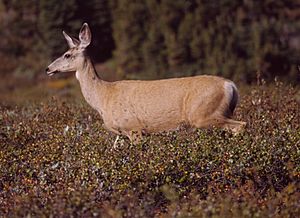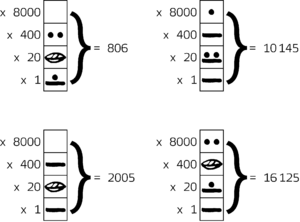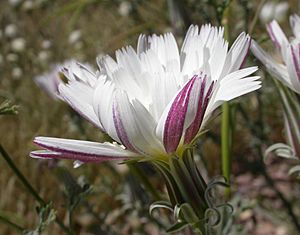Constantine Samuel Rafinesque facts for kids
Quick facts for kids
Constantine Samuel Rafinesque
|
|
|---|---|
 |
|
| Born |
Constantine Samuel Rafinesque-Schmaltz
October 22, 1783 Galata, Constantinople, Ottoman Empire
|
| Died | September 18, 1840 (aged 56) Philadelphia, United States
|
| Nationality | French |
| Scientific career | |
| Fields | biologist |
| Author abbrev. (botany) | Raf. |
Constantine Samuel Rafinesque-Schmaltz (October 22, 1783 – September 18, 1840) was a very smart French scientist from the 1800s. He was born near Constantinople and taught himself many things in France.
Later, he moved to the United States in 1815. He made important discoveries about plants, animals, and ancient earthworks (old mounds built by early people) in North America. He also studied old languages from Central America. Rafinesque was a genius who knew a lot about many different subjects. He wrote many books and articles about biology, geology, and languages. However, other scientists didn't always accept his ideas during his lifetime.
Contents
Biography
Constantine Samuel Rafinesque was born on October 22, 1783, in Galata, a part of Constantinople. His father was a French merchant, and his mother was of German background. His father passed away when Rafinesque was about 10 years old.
Rafinesque grew up in Marseilles, France. He never went to a university but taught himself almost everything he knew. By age 12, he was already collecting plants. By 14, he had learned Greek and Latin so he could read more books.
In 1802, when he was 19, Rafinesque sailed to Philadelphia, United States. He met many of the few plant scientists in the young country. In 1805, he went back to Europe and lived in Palermo, Sicily. There, he became very successful in trade. By age 25, he stopped working in trade to focus completely on studying nature. He discovered and named many new types of plants and fish in Sicily.
Career in the United States
In 1815, Rafinesque returned to the United States. His ship sank near Connecticut, and he lost all his books and natural specimens, including over 60,000 shells. He settled in New York and helped start the Lyceum of Natural History.
In 1817, his book about plants in Louisiana was criticized by other scientists. This made some people ignore his future writings. But by 1818, he had already found and named more than 250 new kinds of plants and animals. He slowly started to rebuild his collection.
In 1818, Rafinesque met another naturalist, John James Audubon, in Kentucky. Audubon played some jokes on Rafinesque, making up imaginary animals.
In 1819, Rafinesque became a professor of botany (the study of plants) at Transylvania University in Kentucky. He also taught French, Italian, and Spanish. He became interested in the ancient earthworks found in the Ohio Valley. He measured and mapped these old mounds.
Rafinesque kept recording all the new plants and animals he found during his travels. In 1826, he left the university after a disagreement with its president. He moved to Philadelphia, a big center for publishing and research. He published his own journal, The Atlantic Journal and Friend of Knowledge, and gave public lectures. He also continued to publish many books, often paying for them himself.
Death
Rafinesque died in Philadelphia on September 18, 1840, from an illness. He was buried in Ronaldson's Cemetery. Later, in 1924, what were believed to be his remains were moved to Transylvania University. They were reburied in a special tomb with the words, "Honor to whom honor is overdue."
Work
Biology
Rafinesque gave scientific names to 6,700 kinds of plants. He also named many new types of animals. The large number of new species he identified made him famous among biologists.

Rafinesque wanted to join the famous Lewis and Clark Expedition, but he was not chosen. However, after studying the specimens they collected, he gave scientific names to animals like the black-tailed prairie dog, the white-footed mouse, and the mule deer.
Evolution
Rafinesque was one of the first people to use the word "evolution" when talking about how living things change over time. He suggested his own idea of evolution before Charles Darwin published his famous book.
In 1861, Charles Darwin even mentioned Rafinesque's ideas in a later edition of his book On the Origin of Species. Rafinesque believed that species are not fixed. He thought they slowly change over time, calling these changes "mutations." He said evolution happened "by gradual steps at remote irregular periods." He also thought these changes applied to humans.
Walam Olum
In 1836, Rafinesque published a book that included the Walam Olum. This was supposed to be an ancient story of the Lenape people (also known as the Delaware Indians). It told how they migrated to the lands around the Delaware River.
Rafinesque claimed he had found wooden tablets with pictures and writings from the Lenape. He said he translated these into English. However, he later said the original tablets were lost. For a long time, many historians believed the Walam Olum was a real Native American story. But starting in the 1980s, many experts began to think it was not real. They believe Rafinesque might have been tricked, or perhaps he created the story himself. Some people, including some Lenape, still believe the story is real.
Study of prehistoric cultures
Rafinesque made important contributions to understanding ancient North American cultures. He studied the old earthworks (mounds) built by the Adena culture and Hopewell tradition in the Ohio River Valley. He was the first to call these the "Ancient Monuments of America." He listed more than 500 such sites in Ohio and Kentucky.
Rafinesque did not dig at these sites. Instead, he carefully measured, sketched, and described them. His work helped other scientists, like E. G. Squier and Davis, who used Rafinesque's findings for their important book for the Smithsonian Institution.
Rafinesque also studied ancient cultures in Central America. He looked at old writings and languages. He was the first to partly figure out the ancient Maya script in 1832. He explained that their special bar-and-dot symbols represented numbers, with bars meaning fives and dots meaning ones.
Legacy
Historians say Rafinesque was a brilliant but sometimes unusual scientist. His way of working didn't always fit with how science was becoming more organized. Many of his ideas were debated by other scientists. Some thought he was too quick and claimed credit for others' work. Scientists were also concerned that his ideas about evolution, long before Darwin, seemed to be based more on his own thoughts than on strong research.
Despite these issues, Rafinesque made huge contributions to the study of nature in America. He named 34 groups and 24 species of American fish. He was also a great teacher at Transylvania University.
- In 1838, a type of fish, the white-spotted lantern fish, was named Diaphus rafinesquii in his honor.
- In 1841, a new group of plants called Rafinesquia was named after him. This group includes two species: California plumeseed and desert chicory.
- In 1892, a group of fossil shells called Rafinesquina was also named after him.
Published works
Rafinesque wrote many books and articles during his life. Here are a few examples:
- 1810: Indice d'ittiologia siciliana (A guide to Sicilian fish)
- 1815: Analyse de la Nature (Analysis of Nature)
- 1817: Florula ludoviciana (Plants of Louisiana)
- 1820: Ichthyologia Ohiensis (Fish of Ohio)
- 1832–1833: Atlantic Journal and Friend of Knowledge (His own journal)
- 1836: A Life of Travels (His autobiography)
- 1836: The American Nations (About ancient cultures)
See also
 In Spanish: Constantine Samuel Rafinesque para niños
In Spanish: Constantine Samuel Rafinesque para niños



